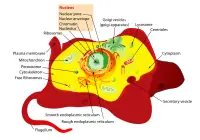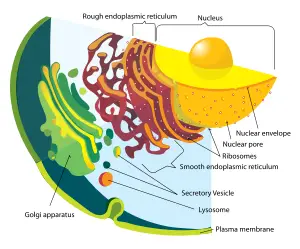Difference between revisions of "Eukaryote" - New World Encyclopedia
m (→Structure) |
|||
| Line 64: | Line 64: | ||
===Internal membranes=== | ===Internal membranes=== | ||
| − | Eukaryotic cells include a variety of membrane-bound structures, collectively referred to as the | + | Eukaryotic cells include a variety of membrane-bound structures, collectively referred to as the endomembrane system. Simple compartments, called vesicles or vacuoles, can form by budding off other membranes. Many cells ingest food and other materials through a process of endocytosis, where the outer membrane invaginates and then pinches off to form a vesicle. It is possible that most other membrane-bound organelles are ultimately derived from such vesicles. |
| − | The nucleus is surrounded by a double membrane (commonly referred to as a nuclear envelope), with pores that allow material to move in and out | + | The nucleus is surrounded by a double membrane (commonly referred to as a nuclear envelope), with pores that allow material to move in and out. Various tube- and sheet-like extensions of the nuclear membrane form what is called the endoplasmic reticulum or ER, which is involved in protein transport. It includes the Rough ER where ribosomes are attached, and the proteins they synthesize enter the interior space or lumen. Subsequently, they generally enter vesicles, which bud off from the Smooth ER. In most eukaryotes, the proteins may be further modified in stacks of flattened vesicles, called Golgi bodies or dictyosomes. |
| − | Vesicles may be specialized for various purposes. For instance, | + | Vesicles may be specialized for various purposes. For instance, lysosomes contain enzymes that break down the contents of food vacuoles, and peroxisomes are used to break down peroxide, which is toxic otherwise. Many protozoa have contractile vacuoles, which collect and expel excess water, and extrusomes, which expel material used to deflect predators or capture prey. In multicellular organisms, hormones are often produced in vesicles. In higher plants, most of a cell's volume is taken up by a central vacuole or tonoplast, which maintains its osmotic pressure. |
[[image:Mitochondrie.svg|thumb|300px| | [[image:Mitochondrie.svg|thumb|300px| | ||
| Line 79: | Line 79: | ||
===Mitochondria and plastids=== | ===Mitochondria and plastids=== | ||
| − | [[Mitochondrion|Mitochondria]] are organelles found in nearly all eukaryotes. They are surrounded by double membranes, the inner of which is folded into invaginations called cristae, where | + | [[Mitochondrion|Mitochondria]] are organelles found in nearly all eukaryotes. They are surrounded by double membranes, the inner of which is folded into invaginations called cristae, where aerobic respiration takes place. They contain their own DNA and are only formed by the fission of other mitochondria. They are now generally held to have developed from endosymbiotic prokaryotes (those living only within other cells), probably proteobacteria. The few protozoa that lack mitochondria have been found to contain mitochondrion-derived organelles, such as hydrogenosomes and mitosomes. |
| − | Plants and various groups of [[alga]]e also have | + | Plants and various groups of [[alga]]e also have plastids. Again, these have their own DNA and developed from endosymbiotes, in this case cyanobacteria. They usually take the form of chloroplasts, which like cyanobacteria contain chlorophyll and produce energy through [[photosynthesis]]. Others are involved in storing food. Although plastids likely had a single origin, not all plastid-containing groups are closely related. Instead, some eukaryotes have obtained them from others through secondary endosymbiosis or ingestion. |
| − | Endosymbiotic origins have also been proposed for the nucleus | + | Endosymbiotic origins have also been proposed for the nucleus (see below), and for eukaryotic flagella, supposed to have developed from spirochaetes (parasitic bacteria). This is not generally accepted, both from a lack of cytological evidence and difficulty in reconciling this with cellular reproduction. |
===Cytoskeletal structures=== | ===Cytoskeletal structures=== | ||
| − | Many eukaryotes have slender motile projections, usually called | + | Many eukaryotes have slender motile projections, usually called flagella, composed from the protein flagelin when long and cilia when short. These projections are involved in movement, feeding, and sensation. They are entirely distinct from prokaryotic flagella. They are supported by a bundle of microtubules arising from a basal body, also called a kinetosome or centriole, characteristically arranged as nine doublets surrounding two singlets. Flagella also may have hairs or mastigonemes, scales, connecting membranes and internal rods. Their interior is continuous with the cell's cytoplasm. |
Centrioles are often present even in cells and groups that do not have flagella. They generally occur in groups of one or two, called kinetids, that give rise to various microtubular roots. These form a primary component of the cytoskeletal structure, and are often assembled over the course of several cell divisions, with one flagellum retained from the parent and the other derived from it. Centrioles may also be associated in the formation of a spindle during nuclear division. | Centrioles are often present even in cells and groups that do not have flagella. They generally occur in groups of one or two, called kinetids, that give rise to various microtubular roots. These form a primary component of the cytoskeletal structure, and are often assembled over the course of several cell divisions, with one flagellum retained from the parent and the other derived from it. Centrioles may also be associated in the formation of a spindle during nuclear division. | ||
Revision as of 03:39, 6 July 2006
| Eukaryotes | ||
|---|---|---|
| Scientific classification | ||
| ||
| Kingdoms | ||
| Animalia - Animals | ||
| Fungi | ||
| Plantae - Plants | ||
| Protista |
A eukaryote is an organism with a complex cell or cells, in which the genetic material is organized into a membrane-bound nucleus or nuclei. Eukaryotes comprise animals, plants, and fungi—which are mostly multicellular—as well as various other groups that are collectively classified as protists (many of which are unicellular). In contrast, prokaryotes are organisms, such as bacteria, that lack nuclei and other complex cell structures and are usually unicellular. Eukaryotes share a common origin, and are often treated formally as a superkingdom, empire, or domain. The name comes from the Greek ευ, meaning good, and κάρυον, meaning nut, in reference to the cell nucleus.
Origin and evolution
The origin of the eukaryotic cell was a milestone in the evolution of life, as it led to the development of so many complex, multicellular organisms. The timing of this series of events is hard to determine; Andrew H. Knoll of Harvard University (1992) suggests that eukaryotes developed approximately 1.6 - 2.1 billion years ago. Fossils that are clearly related to modern groups indicate an evolutionary beginning of around 800 million years ago.
rRNA trees (diagrams meant to convey some evolutionary history) constructed during the 1980s and 1990s left most eukaryotes in an unresolved "crown" group, which was usually divided by the form of the mitochondrial cristae (inner folds of membrane). The few groups of eukaryotes that lack mitochondria branched separately, and so it was believed that the the two groups (those with and those without mitochondria) had diverged very early on in the evolution of eukaryotes. However, this belief is now considered an artifact of long branch attraction (a source of error in phylogenetic trees) and the eukaryotes lacking mitochondria are now considered to have diverged secondarily to mitochondrial endosymbiosis (Germot, Philippe, and Le Guyader 1997). The Endosymbiotic Theory, proposed in 1967 by Lynn Margulis, is now widely accepted and states among other things that mitochondria are the result of cells' endocytosis of aerobic (oxygen-dependent) bacteria.
Most eukaryotes are now included in several supergroups:
| Opisthokonts | Animals, fungi, choanoflagellates, etc. |
| Amoebozoa | Most lobose amoebae and slime molds |
| Rhizaria | Various amoeboid protozoa |
| Excavates | Various flagellate protozoa |
| Archaeplastida | Land plants, green and red algae |
| Heterokonts | Brown algae, diatoms, water molds, etc. |
| Alveolates | Ciliates, Apicomplexa, dinoflagellates, etc. |
The heterokonts and alveolates may be part of a larger group that is ancestrally photosynthetic, called the chromalveolates, but this remains contentious. Otherwise the relationships between the different supergroups are mostly uncertain, and in particular there is dispute about where the root of the evolutionary tree belongs. As a result, the characteristics of the earliest eukaryotes is also widely disputed.
In the 1970s Dr. Carl Woese proposed the division of prokaryotes into two groups: archaebacteria (later shorted to archaea) and eubacteria, due to a large difference in genetic makeup. This system would come to compose the three domain system of eukaryota, eubacteria, and archaea, as opposed to the two domain system of prokaryotes and eukaryotes. Eukaryotes are closely related to archaea, at least in terms of nuclear DNA and genetic machinery. In other respects, such as membrane composition, they are similar to eubacteria. Three main explanations for this have been proposed:
- Eukaryotes resulted from the complete fusion of two or more cells, the cytoplasm forming from a eubacterium and the nucleus from an archaeon (alternatively a virus).
- Eukaryotes developed from Archaea, and acquired their eubacterial characteristics from the proto-mitochondrion.
- Eukaryotes and Archaea developed separately from a modified eubacterium.
The origin of the endomembrane system and mitochondria are also disputed. The phagotrophic hypothesis states the membranes originated with the development of endocytosis and later specialized; mitochondria were acquired by ingestion, like plastids (organelles involved in photosynthesis in plants and algae). The syntrophic hypothesis states that the proto-eukaryote relied on the proto-mitochondrion for food, and so ultimately grew to surround it; the membranes originate later, in part thanks to mitochondrial genes (the hydrogen hypothesis is one particular version).
Reproduction
Nuclear division is often coordinated with cell division. This generally takes place by mitosis, a process where each daughter nucleus acquires the identical chromosome content to the parent nucleus. In most eukaryotes there is also a process of sexual reproduction, typically involving an alternation between haploid generations, where only one copy of each chromosome is present, and diploid generations, where two are present, occurring through nuclear fusion (syngamy) and meiosis. There is considerable variation in this pattern, however.
Eukaryotes have a smaller surface to volume area ratio than prokaryotes, and thus have lower metabolic rates and slower rates of reproduction. In some multicellular organisms, cells specialized for metabolism will have enlarged surface areas, such as intestinal vili.
Structure
Eukaryotic cells are generally much larger than prokaryotes, typically a thousand times by volume. They have a variety of internal membranes and structures, called organelles, and a cytoskeleton composed of microtubules and microfilaments, which play an important role in defining the cell's organization. Eukaryotic DNA is divided into several bundles called chromosomes, which are separated by a microtubular spindle during nuclear division. In addition to asexual cell division, most eukaryotes have some process of sexual reproduction via cell fusion, which is not found among prokaryotes.
Internal membranes
Eukaryotic cells include a variety of membrane-bound structures, collectively referred to as the endomembrane system. Simple compartments, called vesicles or vacuoles, can form by budding off other membranes. Many cells ingest food and other materials through a process of endocytosis, where the outer membrane invaginates and then pinches off to form a vesicle. It is possible that most other membrane-bound organelles are ultimately derived from such vesicles.
The nucleus is surrounded by a double membrane (commonly referred to as a nuclear envelope), with pores that allow material to move in and out. Various tube- and sheet-like extensions of the nuclear membrane form what is called the endoplasmic reticulum or ER, which is involved in protein transport. It includes the Rough ER where ribosomes are attached, and the proteins they synthesize enter the interior space or lumen. Subsequently, they generally enter vesicles, which bud off from the Smooth ER. In most eukaryotes, the proteins may be further modified in stacks of flattened vesicles, called Golgi bodies or dictyosomes.
Vesicles may be specialized for various purposes. For instance, lysosomes contain enzymes that break down the contents of food vacuoles, and peroxisomes are used to break down peroxide, which is toxic otherwise. Many protozoa have contractile vacuoles, which collect and expel excess water, and extrusomes, which expel material used to deflect predators or capture prey. In multicellular organisms, hormones are often produced in vesicles. In higher plants, most of a cell's volume is taken up by a central vacuole or tonoplast, which maintains its osmotic pressure.
Mitochondria and plastids
Mitochondria are organelles found in nearly all eukaryotes. They are surrounded by double membranes, the inner of which is folded into invaginations called cristae, where aerobic respiration takes place. They contain their own DNA and are only formed by the fission of other mitochondria. They are now generally held to have developed from endosymbiotic prokaryotes (those living only within other cells), probably proteobacteria. The few protozoa that lack mitochondria have been found to contain mitochondrion-derived organelles, such as hydrogenosomes and mitosomes.
Plants and various groups of algae also have plastids. Again, these have their own DNA and developed from endosymbiotes, in this case cyanobacteria. They usually take the form of chloroplasts, which like cyanobacteria contain chlorophyll and produce energy through photosynthesis. Others are involved in storing food. Although plastids likely had a single origin, not all plastid-containing groups are closely related. Instead, some eukaryotes have obtained them from others through secondary endosymbiosis or ingestion.
Endosymbiotic origins have also been proposed for the nucleus (see below), and for eukaryotic flagella, supposed to have developed from spirochaetes (parasitic bacteria). This is not generally accepted, both from a lack of cytological evidence and difficulty in reconciling this with cellular reproduction.
Cytoskeletal structures
Many eukaryotes have slender motile projections, usually called flagella, composed from the protein flagelin when long and cilia when short. These projections are involved in movement, feeding, and sensation. They are entirely distinct from prokaryotic flagella. They are supported by a bundle of microtubules arising from a basal body, also called a kinetosome or centriole, characteristically arranged as nine doublets surrounding two singlets. Flagella also may have hairs or mastigonemes, scales, connecting membranes and internal rods. Their interior is continuous with the cell's cytoplasm.
Centrioles are often present even in cells and groups that do not have flagella. They generally occur in groups of one or two, called kinetids, that give rise to various microtubular roots. These form a primary component of the cytoskeletal structure, and are often assembled over the course of several cell divisions, with one flagellum retained from the parent and the other derived from it. Centrioles may also be associated in the formation of a spindle during nuclear division.
Some protists have various other microtubule-supported organelles. These include the radiolaria and heliozoa, which produce axopodia used in flotation or to capture prey, and the haptophytes, which have a peculiar flagellum-like organelle called the haptonema.
See also
ReferencesISBN links support NWE through referral fees
- Germot, A., H. Philippe, and H. Le Guyader (1997). Evidence for loss of mitochondria in Microsporidia from a mitochondrial-type HSP70 in Nosema locustae. Molecular and Biochemical Parasitology 87: 159-168.
- Knoll AH (1992). The early evolution of eu-karyotes: A geological perspective. Science 256 (5057): 622–27. Digital object identifier (DOI): 10.1126/science.1585174.
- T. Cavalier-Smith (2002). The phagotrophic origin of eukaryotes and phylogenetic classification of Protozoa. International Journal of Systematic and Evolutionary Microbiology 52: 297-354.
- W. Martin & M.J. Russell (1992). On the origins of cells: a hypothesis for the evolutionary transitions from abiotic geochemistry to chemoautotrophic prokaryotes, and from prokaryotes to nucleated cells. Philosophical Transactions of the Royal Society B.
- S. L. Baldauf (2003). The Deep Roots of Eukaryotes. Science 300 (5626): 1703–1706. Digital object identifier (DOI): 10.1126/science.1085544.
- Sina M. Adl et al (2005). The New Higher Level Classification of Eukaryotes with Emphasis on the Taxonomy of Protists. Journal of Eukaryotic Microbiology 52 (5): 399. Digital object identifier (DOI): 10.1111/j.1550-7408.2005.00053.x.
Credits
New World Encyclopedia writers and editors rewrote and completed the Wikipedia article in accordance with New World Encyclopedia standards. This article abides by terms of the Creative Commons CC-by-sa 3.0 License (CC-by-sa), which may be used and disseminated with proper attribution. Credit is due under the terms of this license that can reference both the New World Encyclopedia contributors and the selfless volunteer contributors of the Wikimedia Foundation. To cite this article click here for a list of acceptable citing formats.The history of earlier contributions by wikipedians is accessible to researchers here:
The history of this article since it was imported to New World Encyclopedia:
Note: Some restrictions may apply to use of individual images which are separately licensed.


